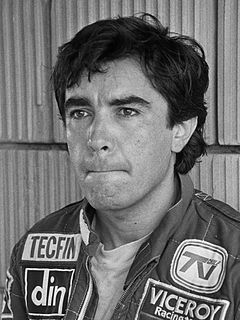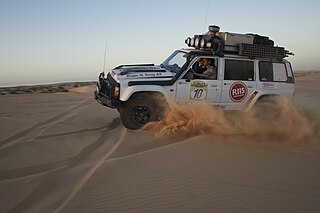
The Dakar Rally is an annual rally raid organised by the Amaury Sport Organisation. Most events since the inception in 1978 were from Paris, France, to Dakar, Senegal, but due to security threats in Mauritania, which led to the cancellation of the 2008 rally, races since 2009 have been held in South America. The race is open to amateur and professional entries, amateurs typically making up about eighty percent of the participants.

Ari Pieti Uolevi Vatanen is a Finnish rally driver turned politician and a Member of the European Parliament (MEP) from 1999 to 2009. Vatanen won the World Rally Championship drivers' title in 1981 and the Paris Dakar Rally four times. Since 2013 Vatanen has been the President of the Estonian Autosport Union.

The Mitsubishi Lancer Evolution, also known as 'Evo', is a sports sedan based on the Lancer that was manufactured by Japanese manufacturer Mitsubishi Motors from 1992 until 2016. There have been ten official versions to date, and the designation of each model is most commonly a Roman numeral. All use two litre turbocharged inline four-cylinder engines and all-wheel drive systems.

Eliseo Salazar Valenzuela is a Chilean racing driver. As of March 2019, he is the only Chilean to have participated in a Formula One World Championship Grand Prix. He made his Formula One debut on 15 March 1981, and ultimately contested 37 races scoring a total of three championship points. After Formula One, Salazar has participated in numerous motorsport disciplines, including the Chilean national rally championship, Formula 3000, IndyCar, and the World Sportscar Championship.
The GS platform is a compact car platform co-developed and shared by Mitsubishi Motors and DaimlerChrysler.
Ralliart is the high-performance and motorsports division of Mitsubishi Motors. It was responsible for development and preparation of the company's rally racing and off-road racing vehicles, as well as the development of high-performance models and parts available to the public. Ralliart scaled down its business activities in April 2010, though the brand will continue to be used by Mitsubishi.
South East (Fujian) Motor Co., Ltd., trading as Soueast, is a Chinese automobile manufacturer based in Fuzhou, Fujian, and a joint venture between China Motor Corporation (25%), Fujian Motor Industry Group (50%) and Mitsubishi Motors (25%). Its principal activity is the design, development, production and sale of passenger cars and minibuses sold under the Soueast marque. It also manufactures Mitsubishi brand passenger cars for sale in mainland China.

Sumo Power is a British car tuning company based in Rye, East Sussex, England. Founded in 2002, Sumo Power specializes in custom tuning Japanese imports, including the Nissan Skyline GT-R and Mitsubishi Lancer Evolution, as well as the importation and sale of many Japanese performance parts, including being an official British distributor for HKS Europe Ltd.
Kenjiro Shinozuka is a Japanese rally driver. Since his debut in 1967, his greatest successes have been as a works driver for Mitsubishi Motors. Behind the wheel of a Galant VR-4 he won the Asia-Pacific Rally Championship in 1988 and scored consecutive victories in the Rallye Côte d'Ivoire Bandama in 1991 and 1992, when it was a round of the World Rally Championship, making him the first Japanese competitor to win a WRC event. He is also of note for his success in the Dakar Rally, where he became the first Japanese winner of the world's most famous endurance rally in 1997 driving a Mitsubishi Pajero.

The Mitsubishi RPM 7000 is a concept car designed by the Cypress, California Design Studio of Mitsubishi Motors and exhibited at the 2001 North American International Auto Show. Displayed alongside the Mitsubishi ASX, the two vehicles represented the company's vision for sporty, stylish crossover SUVs. However, while the ASX defined Mitsubishi's production plans, the RPM 7000 was a more radical styling exercise and an overt celebration of the company's motorsport heritage. The World Rally Championship-winning Mitsubishi Lancer Evolution and the Dakar Rally-winning Mitsubishi Pajero provided the engine and drivetrain, while chief stylist Mike Desmond acknowledged the influence of Formula One in the "nosecone" front grille and hood. Elements of rallying and GT racing were also incorporated. Other unusual elements included the teardrop silhouette, side exit exhaust pipe, and the suicide doors on the passenger side only.

The Mitsubishi Colt 800 is the first of a series of passenger cars with a fastback/hatchback design produced by Mitsubishi Motors from November 1965. It was introduced as a two-door fastback sedan, the first such design in the Japanese market. The series was discontinued in 1971, after the introduction of the company's Galant sedan but without a real replacement.

Rally raid, also known as cross-country rallying, is a form of long distance off-road racing that takes place over several days. The length of the event can be as short as 2-3 days for a cross-country baja to as long as 15 days with marathon rallies like the Dakar Rally; with other cross-country rally events lasting 4-5 days. With skill in navigation being key, the driving skill and endurance of riders, drivers, co-drivers, and machines are put to the test. The total distance covered can be anywhere between 600km to over 5000km with terrain ranging from sandy dunes, forest roads, mountain roads, and dry river beds; among others.

The Mitsubishi Pajero Evolution was an off-road competition car specially designed to take part in the rally raids with the main objective of winning the Dakar Rally.
Mitsubishi Motors concepts are those prototype and concept cars exhibited around the world by Mitsubishi Motors. In common with other automakers, Mitsubishi has used concept cars as both show cars—stylistically adventurous motor show exhibits with no production intentions behind them—or as precursors of future models destined for mass production.

Juho Ville Matias Hänninen is a Finnish rally driver. He is the 2010 Intercontinental Rally Challenge (IRC) champion and 2011 Super 2000 World Rally Championship (S-WRC) champion with co-driver Mikko Markkula driving a works entered Fabia S2000 for Red Bull Škoda. He also won the 2004 Group N Finnish Rally Championship title, and debuted in the World Rally Championship during the 2006 season.
Claudiu David is a Romanian rally driver.

The Mitsubishi Lancer (A70) is the first generation version of Mitsubishi's long-running Lancer nameplate. When introduced in 1973, it filled the gap between the Minica kei car and the considerably larger Galant. It was a replacement for the Colt 1100, last sold in 1971. Although sedan production ended in 1979, vans continued on until 1985. This Lancer also formed the basis for the Lancer Celeste sports coupé of 1975 through to 1981. These Lancers were sold under a multitude of names in different markets.

The Mitsubishi Lancer WRC is a World Rally Car built by Ralliart, Mitsubishi Motors' motorsport division, to compete in the World Rally Championship. The previous Lancer Evolution series were homologated for the Group A class, and their competitiveness against World Rally Cars from other manufacturers was therefore limited.














